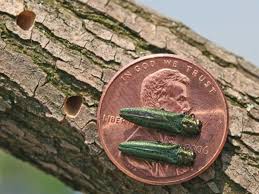
Forest pest experts are investigating reports that the invasive emerald ash borer may have been found in Tarrant County.
Last week, entomologists identified EAB in a photograph submitted to an online nature social network. The photo was taken by a young naturalist, just 10 years old.
Texas A&M Forest Service entomologist, Allen Smith, and urban forester Courtney Blevins teamed up with entomologist Mike Merchant from Texas AgriLife Extension Service, biologist Sam Kieschnick from Texas Parks and Wildlife Department and specialists with USDA Animal and Plant Health Inspection Service to investigate the report of this exotic beetle.
The emerald ash borer is a destructive, non‐native, wood‐boring pest of ash trees. EAB is a significant threat to urban, suburban and rural forests, killing ash trees within two to five years after they become infested.
Native to Asia, the emerald ash borer was discovered in North America in Michigan in 2002. Since then, infestations of this invasive pest have spread to more than half the states in America — killing millions of ash trees.
The beetle was first detected in Texas in 2016 in Harrison County in northeast Texas. Earlier this summer, adult EAB beetles also were caught in survey traps in neighboring Marion and Cass counties, though no infestations have been reported. Traps are set in the spring of each year to catch emerging adult beetles. This year, Texas A&M Forest Service deployed 450 traps across the state.
Since positive identification of EAB cannot be confirmed by a photograph alone, the current investigation in Tarrant County is to locate an adult or larval specimen of the insect. Survey traps close to the area of concern were checked but no EAB was found. Several dead ash trees were discovered, however, the damage was not consistent with EAB and no specimens were located. Therefore, the trees cannot be identified as having been killed by EAB.
Texas A&M Forest Service plans to sample suspected host ash trees this winter to look for developing larvae and place additional survey traps in the immediate area next spring.
Based on historical movement patterns, once EAB was detected in Texas, forestry experts predicted that urban areas in and around Dallas-Fort Worth would be particularly affected. Officials immediately began warning and educating communities on how they could prepare for and protect against EAB infestation.
“With EAB, it’s not if, but when the devastation of the state’s ash trees will occur,” said Blevins. “We can’t stop this epidemic, but we can help communities minimize loss, diversify their tree species and contribute to the health and resiliency of their urban forests.”
Homeowners can watch their ash trees for signs of EAB infestation. Symptoms may include dead branches near the top of a tree, leafy shoots sprouting from the trunk, bark splits exposing larval galleries, extensive woodpecker activity and “D” shaped exit holes in the bark.
Homeowners also have to decide whether they are willing to save their ash tree. If it’s a tree that provides shade to a sun-porch or if it was planted in memory of a loved one, the answer may be ‘yes’. Visit http://texasforestservice.tamu.edu/eab/ for options. If the answer is ‘no’, the tree can be turned into mulch or used for firewood. But if using it for firewood, it should not be moved because transporting firewood is a known vehicle for EAB dispersal. EAB can survive for up to two years after a tree is cut down. Learn more at https://www.dontmovefirewood.org/.
Download the EAB Community Preparedness Plan at http://ow.ly/4uv130lazCW.
EAB photos and resources can be viewed at http://ow.ly/LIJi30lbBxz
To report emerald ash borer, please call 1-866-322-4512.
Contacts
Allen Smith, Regional Forest Health Coordinator, 903-297-5094, lasmith@tfs.tamu.edu
Texas A&M Forest Service Communications Office, 979-458-6614, newsmedia@tfs.tamu.edu








 EastTexasRadio.com Powered by Ten Stations
EastTexasRadio.com Powered by Ten Stations




